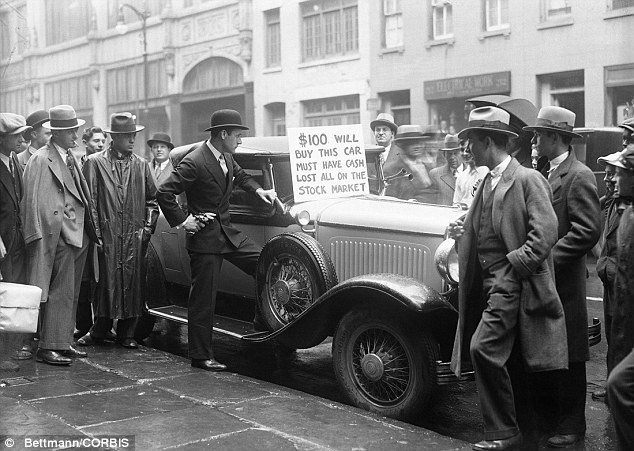What Is Wall Street How It Works History Crashes
Post on: 6 Апрель, 2015 No Comment

Wall Street is both the symbolic and geographic center of American capitalism. Symbolically, Wall Street refers to all the banks, hedge funds. and securities traders that drive the American financial system. Geographically, Wall Street is the center of Manhattan’s financial district. It runs east/west for eight blocks from Broadway to South Street.
Located on Wall Street itself is the New York Stock Exchange (11 Wall Street). Nearby, but still considered part of Wall Street, are the New York Federal Reserve Bank (33 Liberty Street), the NASDAQ OMX (1 Liberty Place), Goldman Sachs (200 West Street), JPMorgan Chase (200 Park Avenue), the NYMEX, (One North End Avenue in the World Financial Center) and the new World Trade Towers — to name just a few. Even the Wall Street Journal is not on Wall Street itself (1211 Avenue of the Americas).
How Does Wall Street Work?:
Wall Street is a symbol for the U.S. financial markets. which includes the stock market. bond market. commodities market. futures market and the foreign exchange market. The original purpose of the securities market was to raise funds for companies to grow, be profitable, and create jobs. However, securities trading has become so profitable in and of itself that trades have been established for just about anything you can think of, and a lot of things you could never imagine.
What changed Wall Street? For one thing, the abolition of the Glass-Steagall Act in 1999. This allowed any bank to use depositors’ savings to invest in complicated securities called derivatives. They based their value on different types of loans, including credit card debt, corporate bonds and mortgages. Unlike stocks and bonds, these derivatives were unregulated.
Wall Street and the 2008 Financial Crisis:
This deregulation was one reason for the 2008 financial crisis. The derivatives based on mortgages were called mortgage-backed securities. They were guaranteed by another Wall Street innovation called credit default swaps. All of these were traded successfully on the secondary market until housing prices started to fall in 2006. The underlying mortgages started to default, and no one knew how to price the mortgage-backed securities. There were so many defaults that the companies, like AIG, who guaranteed the debt ran out of cash.
Wall Street panicked, global stock markets dropped, and banks stopped lending to each other — creating the worst recession since the Great Depression for Main Street. The only thing that stopped the panic was the Federal government bailing out Wall Street with the TARP program in 2008, and restoring confidence with the Economic Stimulus Package in 2009.
Wall Street Crash of 1929:
This wasn’t the first time Wall Street decimated Main Street. The stock market crash of 1929 kicked off the Great Depression. It started on October 24, 1929 — a day known as Black Thursday. It worsened on Black Tuesday. when the Dow lost all the gains of the year in just a few hours. Wall Street bankers had failed in trying to stop plummeting stock prices.
Many individual investors had put their life savings into the stock market. When they got wiped out, they lost confidence in Wall Street and the American economy. Others withdrew all their savings from banks, which then collapsed. Many people felt that Wall Street was the economy. It was only massive government spending on the New Deal and World War II that revived economic growth.
More Regulation for Wall Street:
In 2010, Congress passed the Dodd-Frank Wall Street Reform Act to prevent another financial crisis by giving the Federal government more oversight of Wall Street. For example, non-bank financial firms like hedge funds were required to register with the Securities and Exchange Commission (SEC) and provide information about their trades and total holdings. If any financial firms got too big to fail. Dodd-Frank’s Financial Oversight Committee would recommend they be regulated by the Federal Reserve.
Dodd-Frank required that the riskiest derivatives be regulated by the SEC or the Commodity Futures Trading Commission (CFTC). It asked the agencies to set up a derivatives clearinghouse, like the stock exchange, to make these transactions more transparent.
Occupy Wall Street:
Occupy Wall Street was another reaction to the financial crisis. It’s a leaderless resistance movement that began on September 17, 2011 with a non-violent occupation of Liberty Square in New York’s Financial District. It spread to over 1,500 cities around the world.
Occupy Wall Street opposes income inequality. in which 1% of the world’s population owns 40% of its wealth. They blame Wall Street for creating the financial crisis, recession and resultant long-term unemployment. They are working to take back the democratic process, which they claim is being controlled by Wall Street’s money, connections and power.
Specifically, they stand for:
- A transparent participatory democracy.
- Personal and collective responsibility.
- Recognizing individual rights.
- Collective resistance of oppression.
- More value for labor.
- Individual privacy.
- Education as human right.
- Making technologies, knowledge, and culture open to all. (Source: Occupy Wall Street, Principles of Solidarity )
History of Wall Street:
Wall Street ran along an actual wall built when New York was still a Dutch Colony. Then-Governor Peter Stuyvesant ordered a 10-foot wooden wall that protected the lower peninsula from the British and Native Americans. It later became a street bazaar where traders met under a now-famous buttonwood tree. In 1792 these traders formalized the rules of the game and created the New York Stock Exchange. (Source: CNBC, How Wall Street Got Its Name )
Wall Street Bull:
The Wall Street bull is a statue that symbolizes Wall Street. A bull market is when stock prices rise, and is considered more profitable than a bear market. although savvy Wall Street traders can make money in any market. The Wall Street bull has been moved off of Wall Street to 26 Broadway. Article updated September 7, 2014














